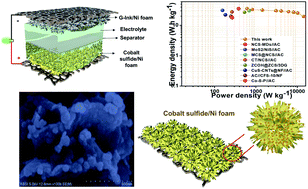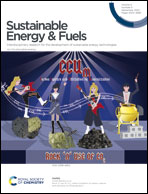A core–shell structure of cobalt sulfide//G-ink towards high energy density in asymmetric hybrid supercapacitors†
Abstract
New atom substitution in transition metals is a promising strategy for improving the performance of supercapacitors (SCs). Herein, we developed a cobalt sulfide core–shell nanostructure composed of nanoflakes and nanoparticles on a nickel foam substrate via a simple synthetic route involving CBD and subsequent sulfide ion-exchange reaction process. The resultant cobalt sulfide nanostructure exhibited enhanced charge transfer and provided abundant active sites with the electrolyte. Consequently, the unique core–shell cobalt sulfide nanostructure demonstrated a higher specific capacity of 450 mA h g−1 in comparison with that of cobalt oxide of 125 mA h g−1 and cobalt selenide of 337 mA h g−1 at a high current density of 5 mA cm−2. Moreover, the cobalt sulfide electrode delivered a good rate capability of 70% of its initial capacity. The core–shell structure of cobalt sulfide was further used to assemble an asymmetric hybrid supercapacitor (AHSC) with graphene ink as the outer electrode, showing a stable and high energy density of 35.43 W h kg−1 at a power density of 612.38 W kg−1, which is comparatively higher than that in recent works. The device exhibited superior cyclic stability of 96% over 5000 cycles. Our results suggest that the hollow core–shell structure is a simple strategy to fabricate high-performance advanced electrode materials for energy conversion and storage technologies.



 Please wait while we load your content...
Please wait while we load your content...